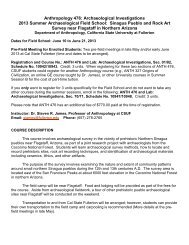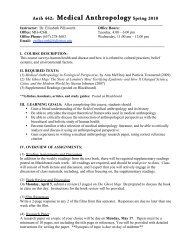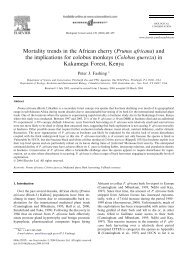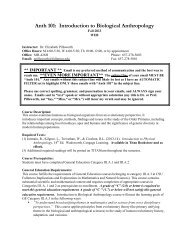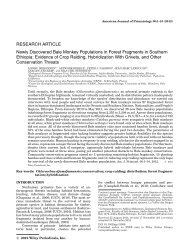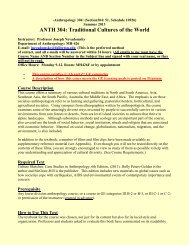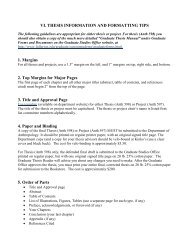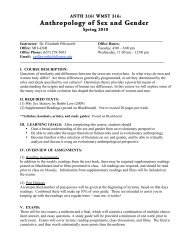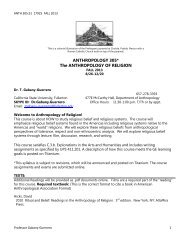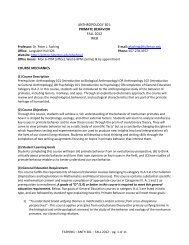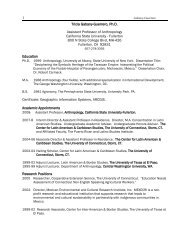Anth 316: Anthropology of Sex and Gender - CSUF Anthropology
Anth 316: Anthropology of Sex and Gender - CSUF Anthropology
Anth 316: Anthropology of Sex and Gender - CSUF Anthropology
You also want an ePaper? Increase the reach of your titles
YUMPU automatically turns print PDFs into web optimized ePapers that Google loves.
<strong>Anth</strong> <strong>316</strong>: <strong>Anth</strong>ropology <strong>of</strong> <strong>Sex</strong> <strong>and</strong> <strong>Gender</strong>Fall 2013Section 01 MW 10:00 – 11:15 MH 408Section 02 MW 2:30 – 3:45 MH 408Instructor: Dr. Elizabeth PillsworthOffice Hours: M 4:00-5:30, W 4:00-5:30; Th 10:00-12:00, or by appointmentOffice: MH-426H Phone: 657-278-5603Email: epillsworth@fullerton.edu Fax: 657-278-5001** IMPORTANT ** Email is my preferred method <strong>of</strong> communication <strong>and</strong> the best way toreach me. **EVEN MORE IMPORTANT** The subject line <strong>of</strong> your email MUST BE“<strong>Anth</strong> <strong>316</strong>.” Any emails without this subject line will likely be lost as I have an AUTOMATICFILTER set to highlight ONLY those emails with “<strong>Anth</strong> <strong>316</strong>” in the subject line.Please use correct spelling, grammar, <strong>and</strong> punctuation in your emails, <strong>and</strong> ALWAYS sign yourname. Emails sent in “text” speak or without appropriate salutation (my title is Dr. or Pr<strong>of</strong>.Pillsworth, not “hey,” “Miss,” or “Mrs.”) will incur my wrath <strong>and</strong> may be ignored.Course Description:This course examines questions <strong>of</strong> sex <strong>and</strong> gender from an evolutionary perspective. Why are women<strong>and</strong> men so different? In what ways are they similar? How do ecology <strong>and</strong> resources relate to sexuality,gender differences, <strong>and</strong> jealousy? Can a Darwinian perspective help us underst<strong>and</strong> sexual orientation,mate preferences, <strong>and</strong> love? We will begin with a brief introduction to evolutionary theory <strong>and</strong>behavioral ecology to help us put the concepts <strong>of</strong> “male” <strong>and</strong> “female” into a broader context. We willthen examine the reproductive systems <strong>of</strong> humans <strong>and</strong> our closest living relatives, the great apes. Fromthere will explore women’s <strong>and</strong> men’s sexual psychologies: mate preferences, reproductive strategies, <strong>and</strong>sexual desire. We will look at how an underst<strong>and</strong>ing <strong>of</strong> sex <strong>and</strong> gender can help us underst<strong>and</strong> patterns <strong>of</strong>behavior as variant as patriarchy, politics, cooperation, <strong>and</strong> warfare.Required Texts:(1) Low, Bobbi S. 2000. Why <strong>Sex</strong> Matters: A Darwinian Look at Human Behavior. Princeton UniversityPress. Available in the TITAN Bookstore.(2) Quirk, Joe. 2006. It’s Not You, It’s Biology: The Science <strong>of</strong> Love, <strong>Sex</strong>, <strong>and</strong> Relationships.Philadelphia, Running Press. Link posted on TITANium.(3) Additional required readings will be posted on TITANium throughout the semester.NOTE: What’s Love Got to Do with It, by Meredith Small, will NOT be used this semester.Course Prerequisites:Students must have completed General Education Category III.C.1 – Introduction to Social Sciences.General Education Requirements:• <strong>Anth</strong> <strong>316</strong> fulfills General Education Category IV: Lifelong Learning• <strong>Anth</strong> <strong>316</strong> fulfills General Education Category V: Cultural Diversity
<strong>Anth</strong>ropology <strong>of</strong> <strong>Sex</strong> <strong>and</strong> <strong>Gender</strong> as a General Education Requirement:UPS 411.201 requires all GE classes to include a writing assignment.• “Writing assignments in General Education courses should involve the organization <strong>and</strong> expression <strong>of</strong>complex data or ideas <strong>and</strong> careful <strong>and</strong> timely evaluations <strong>of</strong> writing so that deficiencies are identified <strong>and</strong>suggestions for improvement <strong>and</strong>/or for means <strong>of</strong> remediation are <strong>of</strong>fered. Assessments <strong>of</strong> the student’swriting competence shall be used in determining the final course grade.” Your reading questions <strong>and</strong> papersfulfill this requirement because you will organize <strong>and</strong> express complex data <strong>and</strong> ideas related to your growingunderst<strong>and</strong>ing <strong>of</strong> the foundations <strong>of</strong> human behavioral ecology. You will receive timely feedback <strong>and</strong> you willhave the opportunity to edit your response paper <strong>and</strong> resubmit it.According to our university, General Education courses fulfilling category IV (Lifelong Learning) shouldaddress the issues listed below.• “Further students’ own critical self-underst<strong>and</strong>ing <strong>and</strong> acquire the knowledge, skills, <strong>and</strong> attitudes necessaryto engage <strong>and</strong> reflect in learning <strong>and</strong> self-development practices.” Students will be required to criticallyevaluate popular media representations <strong>of</strong> sex <strong>and</strong> gender, <strong>and</strong> reflect how these relate to their own selfunderst<strong>and</strong>ing.• “Develop strategies to be integrated physiological, socio-cultural, <strong>and</strong> psychological beings to promote aholistic awareness <strong>of</strong> lifelong learning throughout their lives.” Students will learn about sex <strong>and</strong> gender fromthe perspectives <strong>of</strong> biological evolution, cultural norms, <strong>and</strong> psychology, allowing them to integrate theseperspectives in their underst<strong>and</strong>ing <strong>of</strong> self, <strong>and</strong> apply a similar holistic approach to other areas <strong>of</strong> their lives.• “Actively apply <strong>and</strong> participate in developing lifelong commitment to health for both personal well-being <strong>and</strong>societal responsibility.” Topics will include sexual behavior, risk-taking, aggression, cooperation, <strong>and</strong>reproduction <strong>and</strong> require students to apply theoretical knowledge to real-world, every-day situations• “Develop themselves as responsible citizens, employees <strong>and</strong> employers, family members, <strong>and</strong> members <strong>of</strong> theglobal society.” Students will learn about human diversity, gender stereotypes, <strong>and</strong> sexual behavior, <strong>and</strong> willbe asked to reflect on notions <strong>of</strong> equity, tolerance, <strong>and</strong> underst<strong>and</strong>ing.According to our university, General Education courses fulfilling category V (Cultural Diversity) should addressthe issues listed below.• “Demonstrate underst<strong>and</strong>ing that culture is socially constructed <strong>and</strong> fundamental to social interaction.”Students will learn about the human capacity for culture <strong>and</strong> the importance <strong>of</strong> cultural learning, <strong>and</strong> how theseapply to cultural variations in gender stereotypes, gender roles, <strong>and</strong> sexual behavior.• “Demonstrate appreciation <strong>of</strong> the complex relationships that various factors such as gender, ethnicity, race,sexual orientation, religion, <strong>and</strong> class bring to a discussion <strong>of</strong> society <strong>and</strong> culture.” The course will drawupon many cross-cultural, cross-temporal, <strong>and</strong> cross-species examples to underst<strong>and</strong> how ecology, evolution,history, <strong>and</strong> culture impact sex <strong>and</strong> gender.• “Demonstrate underst<strong>and</strong>ing that because we live in an inter-connected world, we need to underst<strong>and</strong> thediversity <strong>and</strong> relationships within <strong>and</strong> among cultures.” Students will learn about human diversity, genderstereotypes, <strong>and</strong> sexual behavior both within <strong>and</strong> between cultures, <strong>and</strong> will be asked to apply these ideas toquestions <strong>of</strong> equity <strong>and</strong> tolerance.• “Recognize <strong>and</strong> evaluate how one’s cultural history affects one’s sense <strong>of</strong> self <strong>and</strong> relationship to others.” Inexploring sexual <strong>and</strong> romantic behavior, as well as sex roles <strong>and</strong> gendered-divisions <strong>of</strong> labor, in a crossculturalperspective, students will be required to reflect on their own cultural background <strong>and</strong> how it relates totheir own practices <strong>and</strong> ideas.(Quotes from UPS 411.201).Course Objectives:Our objectives are to develop a deeper underst<strong>and</strong>ing <strong>of</strong>:• <strong>Sex</strong>ual <strong>and</strong> reproductive behavior in humans• Variation in gender roles, sexual behavior, <strong>and</strong> gender identity• Evolutionary theory• The evolution <strong>of</strong> sex roles• How sex <strong>and</strong> gender relate to broader domains <strong>of</strong> human social behavior
Grading:Attendance/participation (10% <strong>of</strong> total grade): I expect you to demonstrate that you have read theassigned chapters <strong>and</strong> articles prior to class, through your engagement in the class discussions. Ido not require you to speak in class (though I strongly encourage it!), but I do require that you areactively engaged in class. You WILL lose points if you are checking email, texting, reading thenewspaper, snoozing, chatting with your neighbor, etc. Attendance is expected for all classmeetings. Regularity <strong>of</strong> attendance or participation in discussions may, at my discretion, be usedto influence a borderline grade (please note that I use the +/- grading system).Discussion Questions (5% <strong>of</strong> total grade): You are required to come to each class with preparedquestions or comments regarding the current material. Students will be called on r<strong>and</strong>omly toread their questions/comments aloud to the class <strong>and</strong> to turn what they’ve written. You will begraded on the questions you turn in.Tests (30% <strong>of</strong> total grade): There will be three short (25 questions) tests for this course. Each test willbe more or less equal in length <strong>and</strong> scope <strong>and</strong> will primarily cover the most recent course contentonly. Tests will be multiple choice <strong>and</strong> short answer format, <strong>and</strong> will be timed. They are closedbooktests.Paper (45% <strong>of</strong> total grade): There is one research paper in this class, but the task will be broken upinto three separate assignments. You will submit an annotated bibliography (30 points) in aboutWeek 6; a first draft <strong>of</strong> the paper (70 points) in about Week 9; <strong>and</strong> a final paper (100 points)during Finals Week. Students must work independently on their papers. Student writingcompetence will be assessed based on the ability to successfully integrate course material <strong>and</strong>apply that integrated knowledge to critical thinking <strong>and</strong> reasoning skills. You will be required toresearch <strong>and</strong> cite articles from peer-reviewed scholarly journals in your papers. Your paper gradewill be the total number <strong>of</strong> points earned out <strong>of</strong> 200 (30 + 70 + 100). This grade will be weightedto make up 45% <strong>of</strong> your final class grade.Peer-Review (10% <strong>of</strong> total grade): You will be required to read <strong>and</strong> review one other student’s firstdraft paper (papers will be r<strong>and</strong>omly assigned <strong>and</strong> reviews will be anonymous to the author).Your review will be graded <strong>and</strong> will comprise 10% <strong>of</strong> your total course grade.Extra Credit: Extra credit opportunities may be provided at pr<strong>of</strong>essor discretion.Grading Scale:A+ 98% or greater C+ 78 – 79%A 92 – 97% C 71 – 77%A- 90 – 91% C- 69 – 70%B+ 88 – 89% D+ 67 – 68%B 82 – 87% D 60 – 66%B- 80 – 81% F 59% or lessSpecial Needs: The learning community at <strong>CSUF</strong> respects all forms <strong>of</strong> diversity. Please see me if youneed accommodations for a registered disability, or to fulfill cultural or religious obligations. Studentswith special needs should contact Disabled Student Services to register <strong>and</strong> learn about the servicesavailable to support their learning. You may learn more from their websitehttp://www.fullerton.edu/disabledservices/index.htm
Academic Integrity: Students are expected to maintain a high st<strong>and</strong>ard <strong>of</strong> academic integrity. Studentswho violate university st<strong>and</strong>ards <strong>of</strong> academic integrity are subject to disciplinary sanctions, including agrade <strong>of</strong> “0” on the assignment, failure in the course, <strong>and</strong> suspension from the university. Sincedishonesty in any form harms the individual, other students, <strong>and</strong> the university, policies on academicintegrity are strictly enforced. Familiarize yourself with the academic dishonesty policy, which can befound in the current student h<strong>and</strong>book or on the web athttp://www.fullerton.edu/senate/PDF/300/UPS300-021.pdfCheating is not fair to students who earn their grades fairly (good or bad!). Dishonesty includes, but isnot limited to, cheating, plagiarizing, fabricating information or citations, facilitating acts <strong>of</strong> academicdishonesty by others, having unauthorized possession <strong>of</strong> examinations, submitting work <strong>of</strong> another personor work previously used without informing the instructor, or tampering with the academic work <strong>of</strong> otherstudents. All students are expected to follow the ethical principles <strong>of</strong> academic integrity. Minimally, if astudent violates these principles in my class, he or she will be required to meet with me outside <strong>of</strong> class<strong>and</strong> redo any work involved, or I may assign a “0” grade on the assignment. Maximally, I will give thestudent a failing grade in the class <strong>and</strong> refer the matter to the Associate Dean <strong>of</strong> Judicial Affairs in theOffice <strong>of</strong> Student Affairs.Emergency Procedures Notice to StudentsThe safety <strong>of</strong> all students attending California State University Fullerton is <strong>of</strong> paramount importance. During an emergency it isnecessary for students to have a basic underst<strong>and</strong>ing <strong>of</strong> their personal responsibilities <strong>and</strong> the University’s emergency responseprocedures. In the event <strong>of</strong> an emergency, please adhere to the following guidelines.Before an emergency occurs:• Know the safe evacuation routes for your specific building <strong>and</strong> floor.• Know the evacuation assembly areas for your building.When an emergency occurs:• Keep calm <strong>and</strong> do not run or panic. Your best chance <strong>of</strong> emerging from an emergency is with a clear head.• Evacuation is not always the safest course <strong>of</strong> action. If directed to evacuate, take all <strong>of</strong> your belongings <strong>and</strong> proceed safelyto the nearest evacuation route.• Do not leave the area. Remember that faculty <strong>and</strong> other staff members need to be able to account for your whereabouts.• Do not re-enter building until informed it is safe by a building marshal or other campus authority.• If directed to evacuate the campus, please follow the evacuation routes established by either parking or police <strong>of</strong>ficers.After an emergency occurs:• If an emergency disrupts normal campus operations or causes the University to close for a prolonged period <strong>of</strong> time (morethan three days), students are expected to complete the course assignments listed on the syllabus as soon as it is reasonablypossible to do so.• Students can determine the University's operational status by checking the University's web site athttp://www.fullerton.edu, calling the University's hotline number at 657-278-4444, or tuning into area radio <strong>and</strong> televisionstations. Students should assume that classes will be held unless they hear or read an <strong>of</strong>ficial closure announcement.



